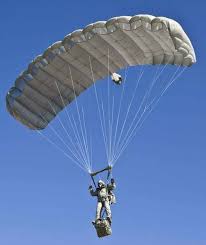Beginner Tips – Low U-Turn (part 3)
 Acceleration using the front free ends has a number of important advantages compared to turning the brakes. Acceleration with the help of the front free ends accelerates the dome, and a turn with brakes, on the contrary, slows it down. This difference is especially apparent at the end of a reversal. After a turn on the front, the dome slows down to its normal speed and tends to return to a neutral position above the pilot. After turning by the brakes, the dome needs to restore speed to normal, so the pilot returns to the neutral position with a significant delay. A turn of the brakes can create a greater pendulum effect, since in it the dome slows down much faster than the pilot under it. On the contrary, when turning with the help of the front free ends, the dome accelerates only slightly faster than the pilot. When turning with brakes, it takes time for the pilot to “swing” back to the neutral position, and the dome to accelerate again to a speed that provides controllability and maximum lift. U-turn at the front free end can be stopped at any time without affecting handling.
Acceleration using the front free ends has a number of important advantages compared to turning the brakes. Acceleration with the help of the front free ends accelerates the dome, and a turn with brakes, on the contrary, slows it down. This difference is especially apparent at the end of a reversal. After a turn on the front, the dome slows down to its normal speed and tends to return to a neutral position above the pilot. After turning by the brakes, the dome needs to restore speed to normal, so the pilot returns to the neutral position with a significant delay. A turn of the brakes can create a greater pendulum effect, since in it the dome slows down much faster than the pilot under it. On the contrary, when turning with the help of the front free ends, the dome accelerates only slightly faster than the pilot. When turning with brakes, it takes time for the pilot to “swing” back to the neutral position, and the dome to accelerate again to a speed that provides controllability and maximum lift. U-turn at the front free end can be stopped at any time without affecting handling.
U-turn by brakes can also be dangerous for loaded domes (specific load 1.4 and higher, depending on type). During a sharp turn, the pilot can swing so hard that when he returns to the dome, the overload may be too high for the dome. In this case, the wing is in a situation of flow stall and becomes completely uncontrollable. In this case, brake braking may not help, moreover, it can lead to an even greater loss of lift. All that helps the implementation of the “pillow” in a situation when you are parallel to the surface – will move the point of your collision with the ground.
Finally, when jumping with most types of canopies, the pilot’s turn by the brakes takes the farther out from under the canopy, compared to a turn using the front free ends. The dome in the frontal projection is concave in relation to the pilot and the ground, and a steep turning angle in such a situation means a much faster loss of height. This is due to the fact that the vertical component of the lifting force of such wings in the rotation is rapidly reduced.
All of the above, however, should not be taken as an unambiguous recommendation in favor of turns with the help of the front free ends. There is a phenomenon that can lead to a complete folding of the dome when performing a high-speed turn – and especially a turn using the front free ends on some types of domes. This happens when the relative flow interacting with the wing dramatically changes its characteristics – angle of attack, pitch angle or something else – for example, as a result of another dome entering the satellite stream. The relative flow in this case does not blow on the leading edge of the wing, but on its plane. In the case of a soft dome, this can force air out of the nozzles and cause the dome to fold. Most exposed to this risk are small loaded domes adjusted to a small pitch angle, for which the projection point of the lift is shifted back.
The projection point of the lift force is the point on the upper plane of the wing through which the imaginary lift force vector passes. The dome, at which this point is shifted forward, is very resistant to turbulence, but it will not be as good to plan as a dome with a rear-mounted lift projection point. Domes with a rearward-projected lift projection point develop good speed and have good aerodynamic quality, but are more prone to folding.




